Marketing Strategies of Nike Inc. - A Comprehensive Analysis (HI5004)
VerifiedAdded on 2023/06/04
|10
|2736
|379
Report
AI Summary
This report provides a comprehensive analysis of Nike Inc.'s marketing management, focusing on its evolution from a retailer of Japanese shoes to the world's largest seller of athletic footwear. It examines Nike's mission and vision statements, corporate strategies, and the impact of its slogan "Just Do It." The report delves into Nike's market segmentation strategies, including geographic, demographic, and psychographic segmentation, with a specific focus on the Australian market. It explores Nike's value proposition, positioning strategies, and the application of the 4Ps (Product, Price, Place, and Promotion) within its marketing mix. The analysis highlights Nike's successful brand building, its effective use of advertising, and its adaptation to consumer needs, providing insights into its sustained market leadership and competitive advantages in the global sports industry.
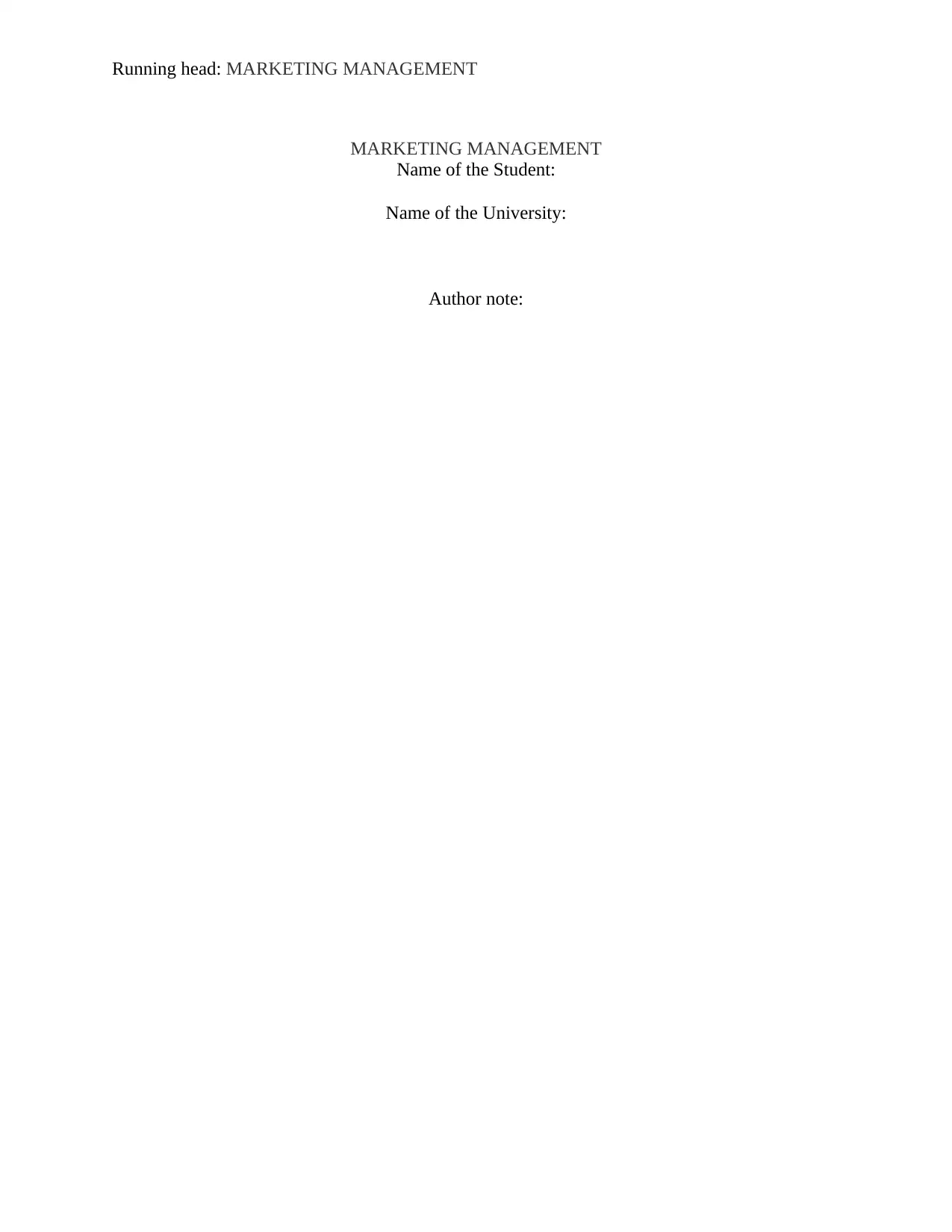
Running head: MARKETING MANAGEMENT
MARKETING MANAGEMENT
Name of the Student:
Name of the University:
Author note:
MARKETING MANAGEMENT
Name of the Student:
Name of the University:
Author note:
Paraphrase This Document
Need a fresh take? Get an instant paraphrase of this document with our AI Paraphraser
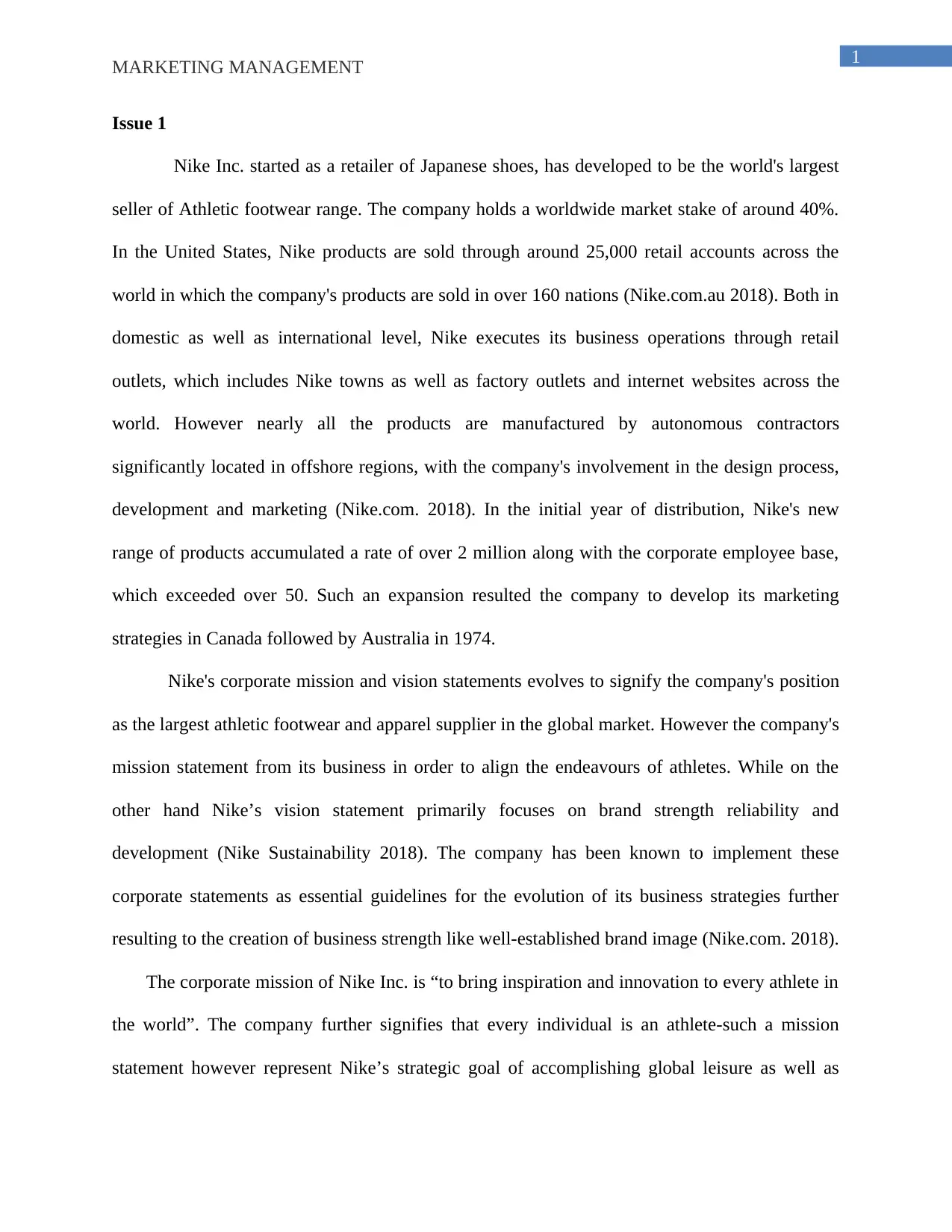
1
MARKETING MANAGEMENT
Issue 1
Nike Inc. started as a retailer of Japanese shoes, has developed to be the world's largest
seller of Athletic footwear range. The company holds a worldwide market stake of around 40%.
In the United States, Nike products are sold through around 25,000 retail accounts across the
world in which the company's products are sold in over 160 nations (Nike.com.au 2018). Both in
domestic as well as international level, Nike executes its business operations through retail
outlets, which includes Nike towns as well as factory outlets and internet websites across the
world. However nearly all the products are manufactured by autonomous contractors
significantly located in offshore regions, with the company's involvement in the design process,
development and marketing (Nike.com. 2018). In the initial year of distribution, Nike's new
range of products accumulated a rate of over 2 million along with the corporate employee base,
which exceeded over 50. Such an expansion resulted the company to develop its marketing
strategies in Canada followed by Australia in 1974.
Nike's corporate mission and vision statements evolves to signify the company's position
as the largest athletic footwear and apparel supplier in the global market. However the company's
mission statement from its business in order to align the endeavours of athletes. While on the
other hand Nike’s vision statement primarily focuses on brand strength reliability and
development (Nike Sustainability 2018). The company has been known to implement these
corporate statements as essential guidelines for the evolution of its business strategies further
resulting to the creation of business strength like well-established brand image (Nike.com. 2018).
The corporate mission of Nike Inc. is “to bring inspiration and innovation to every athlete in
the world”. The company further signifies that every individual is an athlete-such a mission
statement however represent Nike’s strategic goal of accomplishing global leisure as well as
MARKETING MANAGEMENT
Issue 1
Nike Inc. started as a retailer of Japanese shoes, has developed to be the world's largest
seller of Athletic footwear range. The company holds a worldwide market stake of around 40%.
In the United States, Nike products are sold through around 25,000 retail accounts across the
world in which the company's products are sold in over 160 nations (Nike.com.au 2018). Both in
domestic as well as international level, Nike executes its business operations through retail
outlets, which includes Nike towns as well as factory outlets and internet websites across the
world. However nearly all the products are manufactured by autonomous contractors
significantly located in offshore regions, with the company's involvement in the design process,
development and marketing (Nike.com. 2018). In the initial year of distribution, Nike's new
range of products accumulated a rate of over 2 million along with the corporate employee base,
which exceeded over 50. Such an expansion resulted the company to develop its marketing
strategies in Canada followed by Australia in 1974.
Nike's corporate mission and vision statements evolves to signify the company's position
as the largest athletic footwear and apparel supplier in the global market. However the company's
mission statement from its business in order to align the endeavours of athletes. While on the
other hand Nike’s vision statement primarily focuses on brand strength reliability and
development (Nike Sustainability 2018). The company has been known to implement these
corporate statements as essential guidelines for the evolution of its business strategies further
resulting to the creation of business strength like well-established brand image (Nike.com. 2018).
The corporate mission of Nike Inc. is “to bring inspiration and innovation to every athlete in
the world”. The company further signifies that every individual is an athlete-such a mission
statement however represent Nike’s strategic goal of accomplishing global leisure as well as
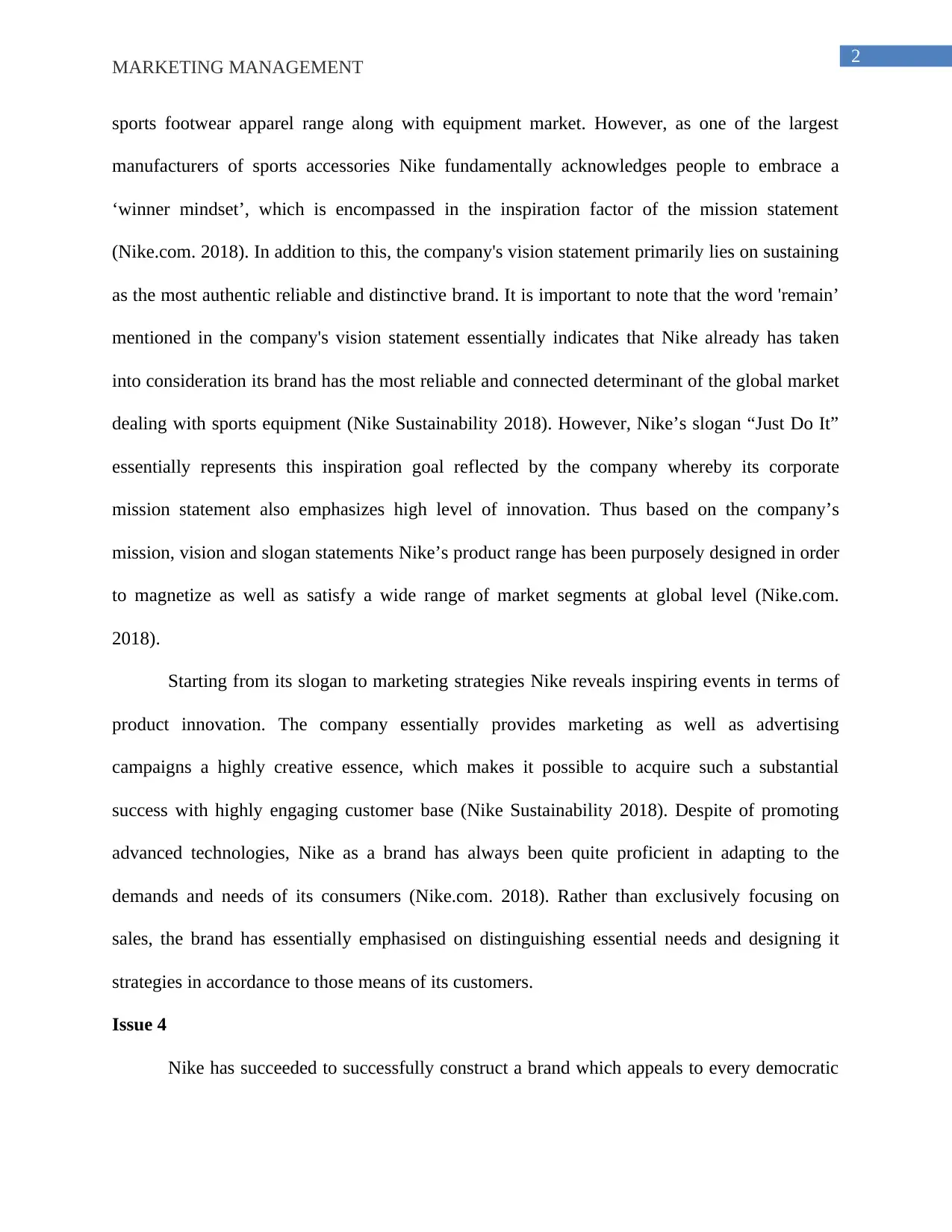
2
MARKETING MANAGEMENT
sports footwear apparel range along with equipment market. However, as one of the largest
manufacturers of sports accessories Nike fundamentally acknowledges people to embrace a
‘winner mindset’, which is encompassed in the inspiration factor of the mission statement
(Nike.com. 2018). In addition to this, the company's vision statement primarily lies on sustaining
as the most authentic reliable and distinctive brand. It is important to note that the word 'remain’
mentioned in the company's vision statement essentially indicates that Nike already has taken
into consideration its brand has the most reliable and connected determinant of the global market
dealing with sports equipment (Nike Sustainability 2018). However, Nike’s slogan “Just Do It”
essentially represents this inspiration goal reflected by the company whereby its corporate
mission statement also emphasizes high level of innovation. Thus based on the company’s
mission, vision and slogan statements Nike’s product range has been purposely designed in order
to magnetize as well as satisfy a wide range of market segments at global level (Nike.com.
2018).
Starting from its slogan to marketing strategies Nike reveals inspiring events in terms of
product innovation. The company essentially provides marketing as well as advertising
campaigns a highly creative essence, which makes it possible to acquire such a substantial
success with highly engaging customer base (Nike Sustainability 2018). Despite of promoting
advanced technologies, Nike as a brand has always been quite proficient in adapting to the
demands and needs of its consumers (Nike.com. 2018). Rather than exclusively focusing on
sales, the brand has essentially emphasised on distinguishing essential needs and designing it
strategies in accordance to those means of its customers.
Issue 4
Nike has succeeded to successfully construct a brand which appeals to every democratic
MARKETING MANAGEMENT
sports footwear apparel range along with equipment market. However, as one of the largest
manufacturers of sports accessories Nike fundamentally acknowledges people to embrace a
‘winner mindset’, which is encompassed in the inspiration factor of the mission statement
(Nike.com. 2018). In addition to this, the company's vision statement primarily lies on sustaining
as the most authentic reliable and distinctive brand. It is important to note that the word 'remain’
mentioned in the company's vision statement essentially indicates that Nike already has taken
into consideration its brand has the most reliable and connected determinant of the global market
dealing with sports equipment (Nike Sustainability 2018). However, Nike’s slogan “Just Do It”
essentially represents this inspiration goal reflected by the company whereby its corporate
mission statement also emphasizes high level of innovation. Thus based on the company’s
mission, vision and slogan statements Nike’s product range has been purposely designed in order
to magnetize as well as satisfy a wide range of market segments at global level (Nike.com.
2018).
Starting from its slogan to marketing strategies Nike reveals inspiring events in terms of
product innovation. The company essentially provides marketing as well as advertising
campaigns a highly creative essence, which makes it possible to acquire such a substantial
success with highly engaging customer base (Nike Sustainability 2018). Despite of promoting
advanced technologies, Nike as a brand has always been quite proficient in adapting to the
demands and needs of its consumers (Nike.com. 2018). Rather than exclusively focusing on
sales, the brand has essentially emphasised on distinguishing essential needs and designing it
strategies in accordance to those means of its customers.
Issue 4
Nike has succeeded to successfully construct a brand which appeals to every democratic
⊘ This is a preview!⊘
Do you want full access?
Subscribe today to unlock all pages.

Trusted by 1+ million students worldwide
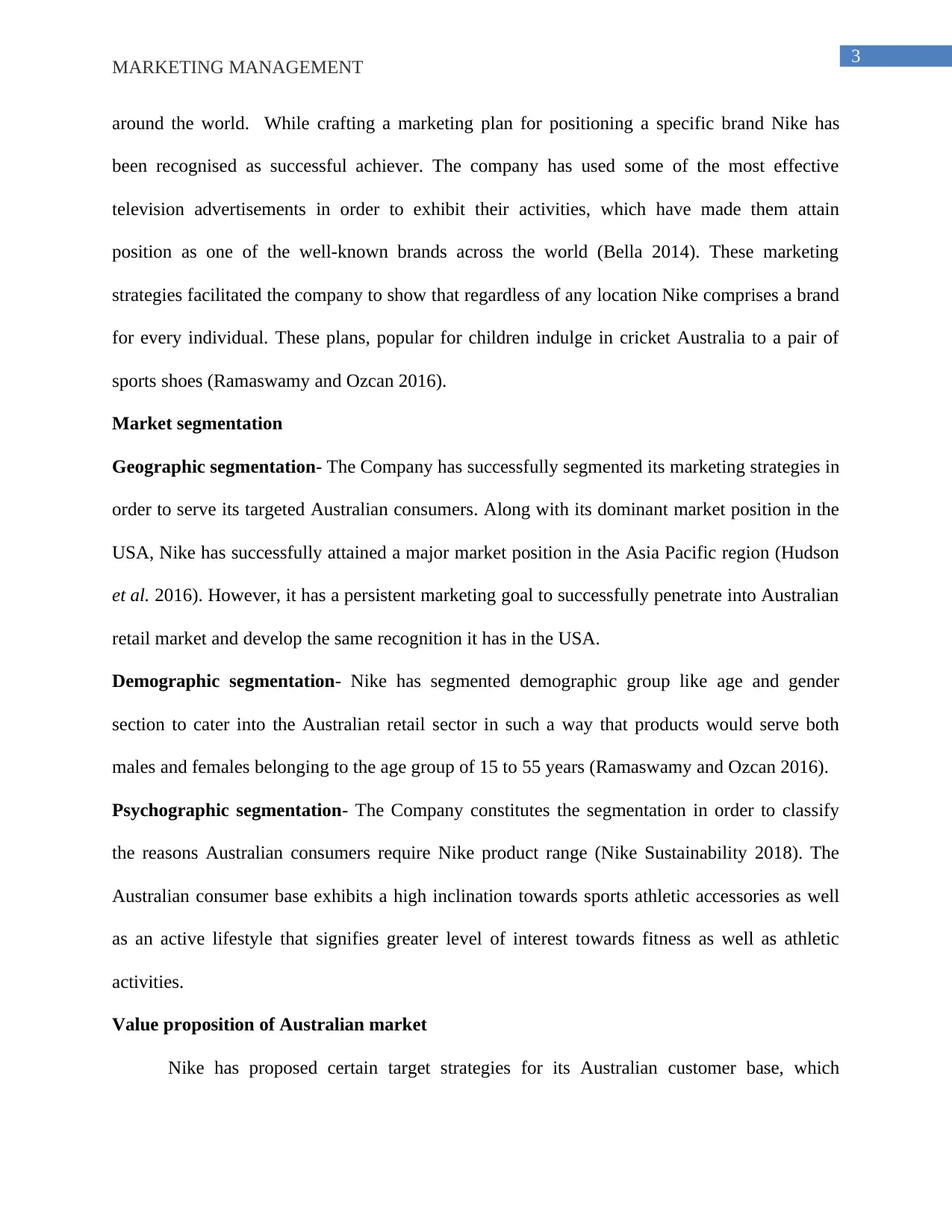
3
MARKETING MANAGEMENT
around the world. While crafting a marketing plan for positioning a specific brand Nike has
been recognised as successful achiever. The company has used some of the most effective
television advertisements in order to exhibit their activities, which have made them attain
position as one of the well-known brands across the world (Bella 2014). These marketing
strategies facilitated the company to show that regardless of any location Nike comprises a brand
for every individual. These plans, popular for children indulge in cricket Australia to a pair of
sports shoes (Ramaswamy and Ozcan 2016).
Market segmentation
Geographic segmentation- The Company has successfully segmented its marketing strategies in
order to serve its targeted Australian consumers. Along with its dominant market position in the
USA, Nike has successfully attained a major market position in the Asia Pacific region (Hudson
et al. 2016). However, it has a persistent marketing goal to successfully penetrate into Australian
retail market and develop the same recognition it has in the USA.
Demographic segmentation- Nike has segmented demographic group like age and gender
section to cater into the Australian retail sector in such a way that products would serve both
males and females belonging to the age group of 15 to 55 years (Ramaswamy and Ozcan 2016).
Psychographic segmentation- The Company constitutes the segmentation in order to classify
the reasons Australian consumers require Nike product range (Nike Sustainability 2018). The
Australian consumer base exhibits a high inclination towards sports athletic accessories as well
as an active lifestyle that signifies greater level of interest towards fitness as well as athletic
activities.
Value proposition of Australian market
Nike has proposed certain target strategies for its Australian customer base, which
MARKETING MANAGEMENT
around the world. While crafting a marketing plan for positioning a specific brand Nike has
been recognised as successful achiever. The company has used some of the most effective
television advertisements in order to exhibit their activities, which have made them attain
position as one of the well-known brands across the world (Bella 2014). These marketing
strategies facilitated the company to show that regardless of any location Nike comprises a brand
for every individual. These plans, popular for children indulge in cricket Australia to a pair of
sports shoes (Ramaswamy and Ozcan 2016).
Market segmentation
Geographic segmentation- The Company has successfully segmented its marketing strategies in
order to serve its targeted Australian consumers. Along with its dominant market position in the
USA, Nike has successfully attained a major market position in the Asia Pacific region (Hudson
et al. 2016). However, it has a persistent marketing goal to successfully penetrate into Australian
retail market and develop the same recognition it has in the USA.
Demographic segmentation- Nike has segmented demographic group like age and gender
section to cater into the Australian retail sector in such a way that products would serve both
males and females belonging to the age group of 15 to 55 years (Ramaswamy and Ozcan 2016).
Psychographic segmentation- The Company constitutes the segmentation in order to classify
the reasons Australian consumers require Nike product range (Nike Sustainability 2018). The
Australian consumer base exhibits a high inclination towards sports athletic accessories as well
as an active lifestyle that signifies greater level of interest towards fitness as well as athletic
activities.
Value proposition of Australian market
Nike has proposed certain target strategies for its Australian customer base, which
Paraphrase This Document
Need a fresh take? Get an instant paraphrase of this document with our AI Paraphraser
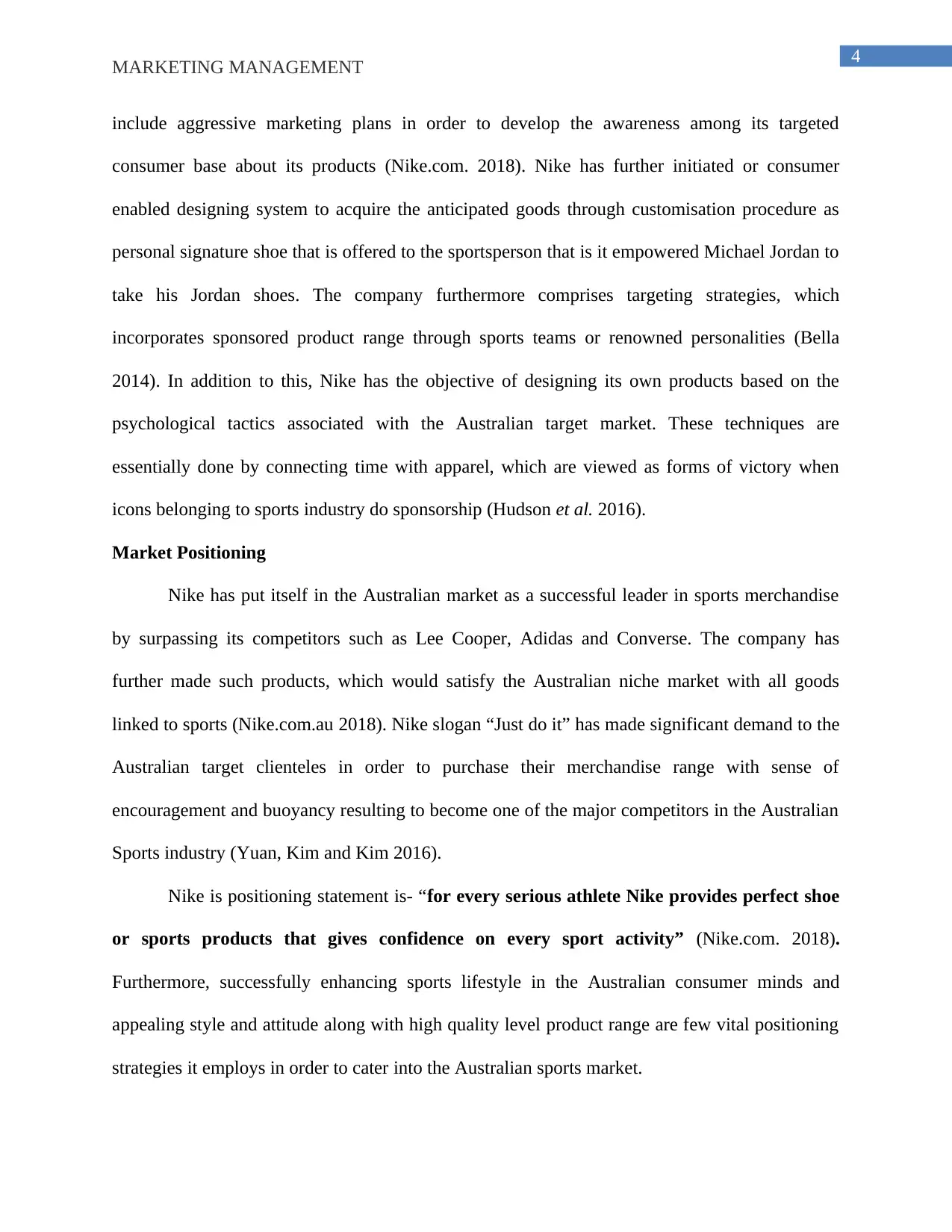
4
MARKETING MANAGEMENT
include aggressive marketing plans in order to develop the awareness among its targeted
consumer base about its products (Nike.com. 2018). Nike has further initiated or consumer
enabled designing system to acquire the anticipated goods through customisation procedure as
personal signature shoe that is offered to the sportsperson that is it empowered Michael Jordan to
take his Jordan shoes. The company furthermore comprises targeting strategies, which
incorporates sponsored product range through sports teams or renowned personalities (Bella
2014). In addition to this, Nike has the objective of designing its own products based on the
psychological tactics associated with the Australian target market. These techniques are
essentially done by connecting time with apparel, which are viewed as forms of victory when
icons belonging to sports industry do sponsorship (Hudson et al. 2016).
Market Positioning
Nike has put itself in the Australian market as a successful leader in sports merchandise
by surpassing its competitors such as Lee Cooper, Adidas and Converse. The company has
further made such products, which would satisfy the Australian niche market with all goods
linked to sports (Nike.com.au 2018). Nike slogan “Just do it” has made significant demand to the
Australian target clienteles in order to purchase their merchandise range with sense of
encouragement and buoyancy resulting to become one of the major competitors in the Australian
Sports industry (Yuan, Kim and Kim 2016).
Nike is positioning statement is- “for every serious athlete Nike provides perfect shoe
or sports products that gives confidence on every sport activity” (Nike.com. 2018).
Furthermore, successfully enhancing sports lifestyle in the Australian consumer minds and
appealing style and attitude along with high quality level product range are few vital positioning
strategies it employs in order to cater into the Australian sports market.
MARKETING MANAGEMENT
include aggressive marketing plans in order to develop the awareness among its targeted
consumer base about its products (Nike.com. 2018). Nike has further initiated or consumer
enabled designing system to acquire the anticipated goods through customisation procedure as
personal signature shoe that is offered to the sportsperson that is it empowered Michael Jordan to
take his Jordan shoes. The company furthermore comprises targeting strategies, which
incorporates sponsored product range through sports teams or renowned personalities (Bella
2014). In addition to this, Nike has the objective of designing its own products based on the
psychological tactics associated with the Australian target market. These techniques are
essentially done by connecting time with apparel, which are viewed as forms of victory when
icons belonging to sports industry do sponsorship (Hudson et al. 2016).
Market Positioning
Nike has put itself in the Australian market as a successful leader in sports merchandise
by surpassing its competitors such as Lee Cooper, Adidas and Converse. The company has
further made such products, which would satisfy the Australian niche market with all goods
linked to sports (Nike.com.au 2018). Nike slogan “Just do it” has made significant demand to the
Australian target clienteles in order to purchase their merchandise range with sense of
encouragement and buoyancy resulting to become one of the major competitors in the Australian
Sports industry (Yuan, Kim and Kim 2016).
Nike is positioning statement is- “for every serious athlete Nike provides perfect shoe
or sports products that gives confidence on every sport activity” (Nike.com. 2018).
Furthermore, successfully enhancing sports lifestyle in the Australian consumer minds and
appealing style and attitude along with high quality level product range are few vital positioning
strategies it employs in order to cater into the Australian sports market.
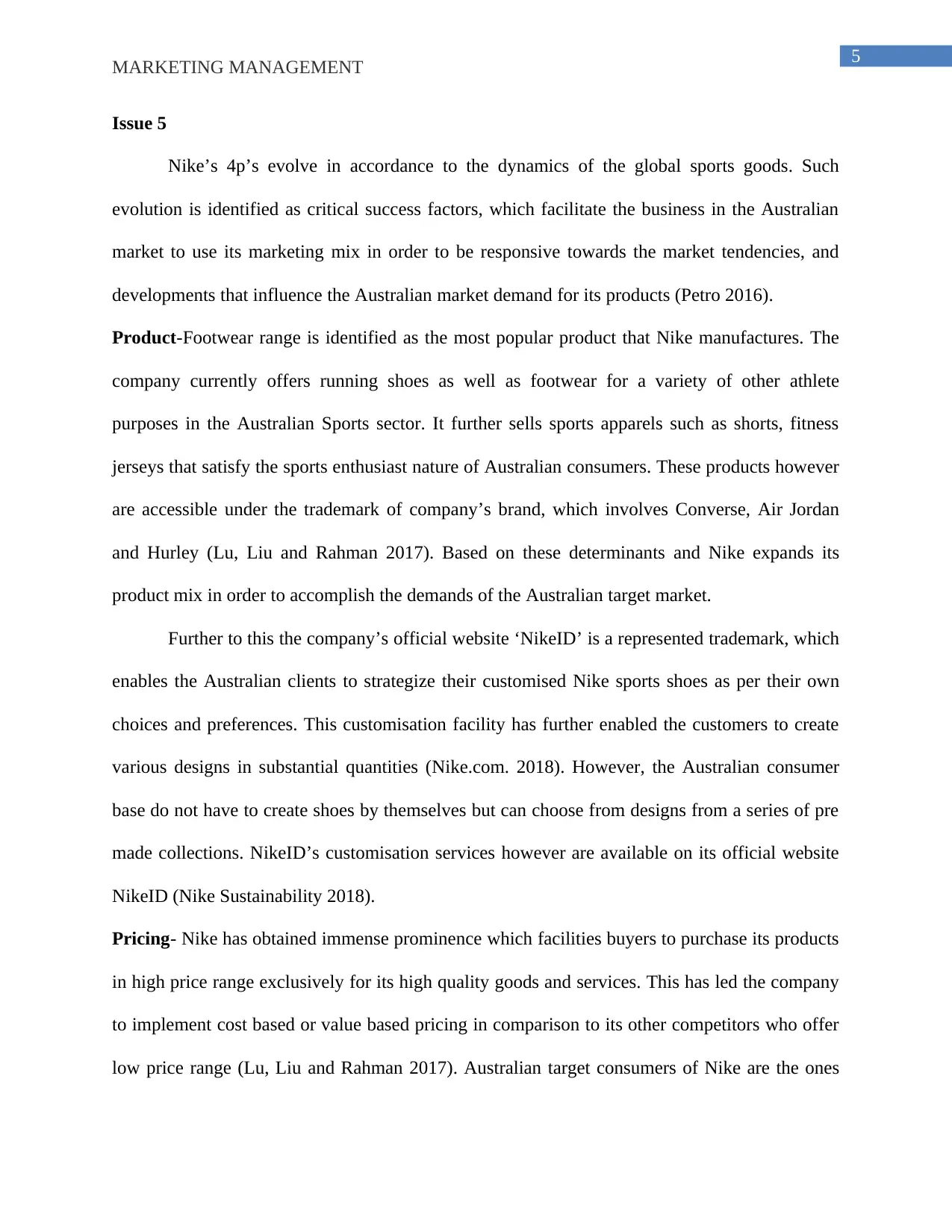
5
MARKETING MANAGEMENT
Issue 5
Nike’s 4p’s evolve in accordance to the dynamics of the global sports goods. Such
evolution is identified as critical success factors, which facilitate the business in the Australian
market to use its marketing mix in order to be responsive towards the market tendencies, and
developments that influence the Australian market demand for its products (Petro 2016).
Product-Footwear range is identified as the most popular product that Nike manufactures. The
company currently offers running shoes as well as footwear for a variety of other athlete
purposes in the Australian Sports sector. It further sells sports apparels such as shorts, fitness
jerseys that satisfy the sports enthusiast nature of Australian consumers. These products however
are accessible under the trademark of company’s brand, which involves Converse, Air Jordan
and Hurley (Lu, Liu and Rahman 2017). Based on these determinants and Nike expands its
product mix in order to accomplish the demands of the Australian target market.
Further to this the company’s official website ‘NikeID’ is a represented trademark, which
enables the Australian clients to strategize their customised Nike sports shoes as per their own
choices and preferences. This customisation facility has further enabled the customers to create
various designs in substantial quantities (Nike.com. 2018). However, the Australian consumer
base do not have to create shoes by themselves but can choose from designs from a series of pre
made collections. NikeID’s customisation services however are available on its official website
NikeID (Nike Sustainability 2018).
Pricing- Nike has obtained immense prominence which facilities buyers to purchase its products
in high price range exclusively for its high quality goods and services. This has led the company
to implement cost based or value based pricing in comparison to its other competitors who offer
low price range (Lu, Liu and Rahman 2017). Australian target consumers of Nike are the ones
MARKETING MANAGEMENT
Issue 5
Nike’s 4p’s evolve in accordance to the dynamics of the global sports goods. Such
evolution is identified as critical success factors, which facilitate the business in the Australian
market to use its marketing mix in order to be responsive towards the market tendencies, and
developments that influence the Australian market demand for its products (Petro 2016).
Product-Footwear range is identified as the most popular product that Nike manufactures. The
company currently offers running shoes as well as footwear for a variety of other athlete
purposes in the Australian Sports sector. It further sells sports apparels such as shorts, fitness
jerseys that satisfy the sports enthusiast nature of Australian consumers. These products however
are accessible under the trademark of company’s brand, which involves Converse, Air Jordan
and Hurley (Lu, Liu and Rahman 2017). Based on these determinants and Nike expands its
product mix in order to accomplish the demands of the Australian target market.
Further to this the company’s official website ‘NikeID’ is a represented trademark, which
enables the Australian clients to strategize their customised Nike sports shoes as per their own
choices and preferences. This customisation facility has further enabled the customers to create
various designs in substantial quantities (Nike.com. 2018). However, the Australian consumer
base do not have to create shoes by themselves but can choose from designs from a series of pre
made collections. NikeID’s customisation services however are available on its official website
NikeID (Nike Sustainability 2018).
Pricing- Nike has obtained immense prominence which facilities buyers to purchase its products
in high price range exclusively for its high quality goods and services. This has led the company
to implement cost based or value based pricing in comparison to its other competitors who offer
low price range (Lu, Liu and Rahman 2017). Australian target consumers of Nike are the ones
⊘ This is a preview!⊘
Do you want full access?
Subscribe today to unlock all pages.

Trusted by 1+ million students worldwide
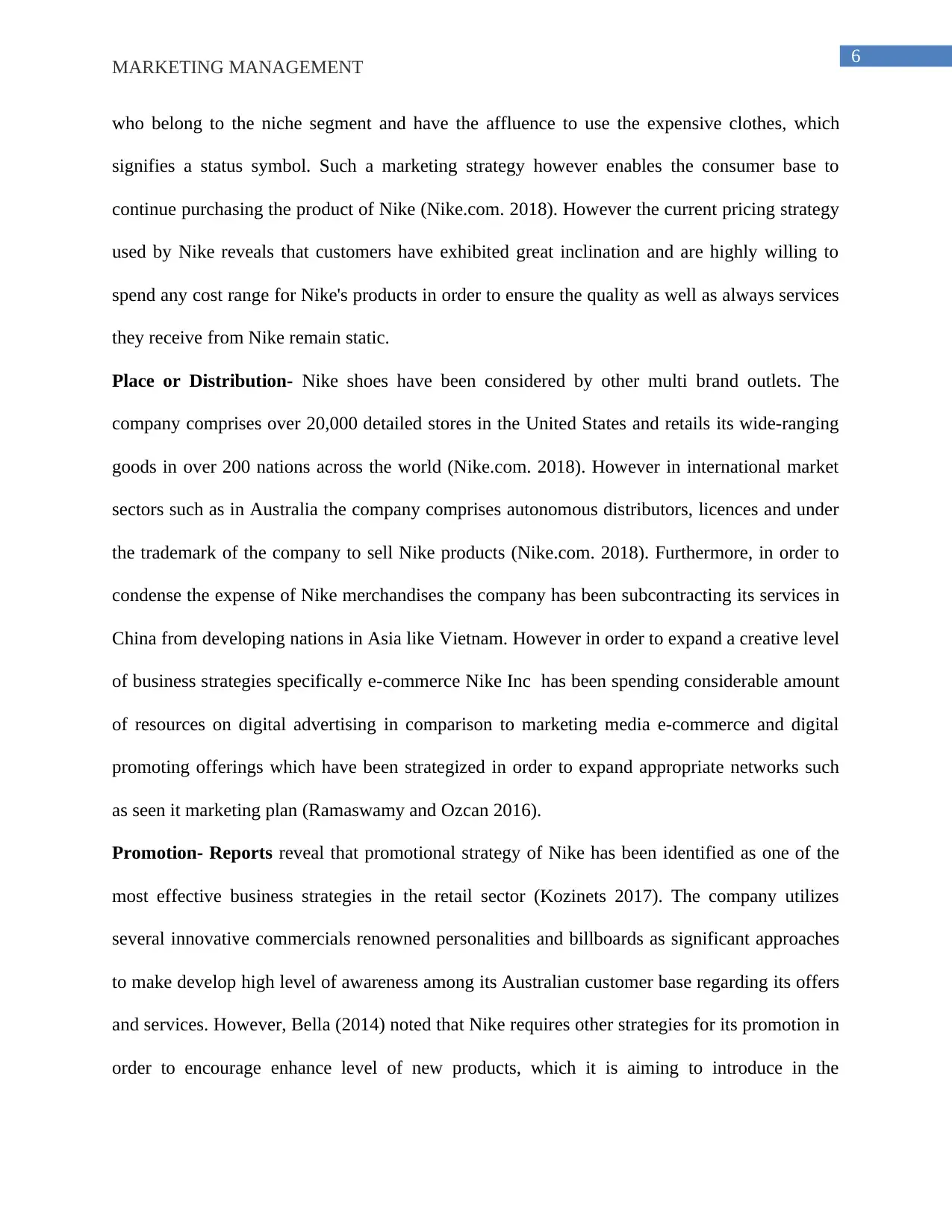
6
MARKETING MANAGEMENT
who belong to the niche segment and have the affluence to use the expensive clothes, which
signifies a status symbol. Such a marketing strategy however enables the consumer base to
continue purchasing the product of Nike (Nike.com. 2018). However the current pricing strategy
used by Nike reveals that customers have exhibited great inclination and are highly willing to
spend any cost range for Nike's products in order to ensure the quality as well as always services
they receive from Nike remain static.
Place or Distribution- Nike shoes have been considered by other multi brand outlets. The
company comprises over 20,000 detailed stores in the United States and retails its wide-ranging
goods in over 200 nations across the world (Nike.com. 2018). However in international market
sectors such as in Australia the company comprises autonomous distributors, licences and under
the trademark of the company to sell Nike products (Nike.com. 2018). Furthermore, in order to
condense the expense of Nike merchandises the company has been subcontracting its services in
China from developing nations in Asia like Vietnam. However in order to expand a creative level
of business strategies specifically e-commerce Nike Inc has been spending considerable amount
of resources on digital advertising in comparison to marketing media e-commerce and digital
promoting offerings which have been strategized in order to expand appropriate networks such
as seen it marketing plan (Ramaswamy and Ozcan 2016).
Promotion- Reports reveal that promotional strategy of Nike has been identified as one of the
most effective business strategies in the retail sector (Kozinets 2017). The company utilizes
several innovative commercials renowned personalities and billboards as significant approaches
to make develop high level of awareness among its Australian customer base regarding its offers
and services. However, Bella (2014) noted that Nike requires other strategies for its promotion in
order to encourage enhance level of new products, which it is aiming to introduce in the
MARKETING MANAGEMENT
who belong to the niche segment and have the affluence to use the expensive clothes, which
signifies a status symbol. Such a marketing strategy however enables the consumer base to
continue purchasing the product of Nike (Nike.com. 2018). However the current pricing strategy
used by Nike reveals that customers have exhibited great inclination and are highly willing to
spend any cost range for Nike's products in order to ensure the quality as well as always services
they receive from Nike remain static.
Place or Distribution- Nike shoes have been considered by other multi brand outlets. The
company comprises over 20,000 detailed stores in the United States and retails its wide-ranging
goods in over 200 nations across the world (Nike.com. 2018). However in international market
sectors such as in Australia the company comprises autonomous distributors, licences and under
the trademark of the company to sell Nike products (Nike.com. 2018). Furthermore, in order to
condense the expense of Nike merchandises the company has been subcontracting its services in
China from developing nations in Asia like Vietnam. However in order to expand a creative level
of business strategies specifically e-commerce Nike Inc has been spending considerable amount
of resources on digital advertising in comparison to marketing media e-commerce and digital
promoting offerings which have been strategized in order to expand appropriate networks such
as seen it marketing plan (Ramaswamy and Ozcan 2016).
Promotion- Reports reveal that promotional strategy of Nike has been identified as one of the
most effective business strategies in the retail sector (Kozinets 2017). The company utilizes
several innovative commercials renowned personalities and billboards as significant approaches
to make develop high level of awareness among its Australian customer base regarding its offers
and services. However, Bella (2014) noted that Nike requires other strategies for its promotion in
order to encourage enhance level of new products, which it is aiming to introduce in the
Paraphrase This Document
Need a fresh take? Get an instant paraphrase of this document with our AI Paraphraser
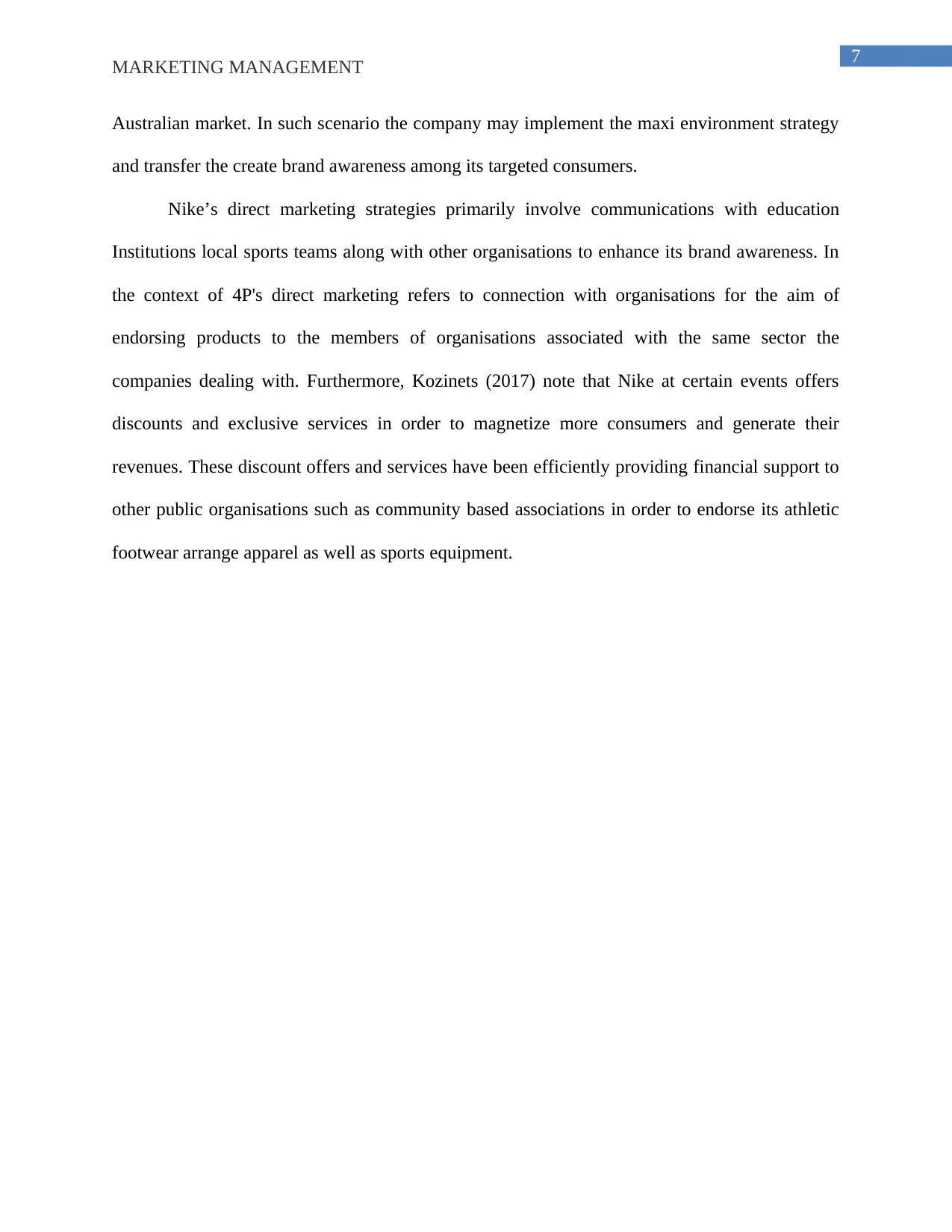
7
MARKETING MANAGEMENT
Australian market. In such scenario the company may implement the maxi environment strategy
and transfer the create brand awareness among its targeted consumers.
Nike’s direct marketing strategies primarily involve communications with education
Institutions local sports teams along with other organisations to enhance its brand awareness. In
the context of 4P's direct marketing refers to connection with organisations for the aim of
endorsing products to the members of organisations associated with the same sector the
companies dealing with. Furthermore, Kozinets (2017) note that Nike at certain events offers
discounts and exclusive services in order to magnetize more consumers and generate their
revenues. These discount offers and services have been efficiently providing financial support to
other public organisations such as community based associations in order to endorse its athletic
footwear arrange apparel as well as sports equipment.
MARKETING MANAGEMENT
Australian market. In such scenario the company may implement the maxi environment strategy
and transfer the create brand awareness among its targeted consumers.
Nike’s direct marketing strategies primarily involve communications with education
Institutions local sports teams along with other organisations to enhance its brand awareness. In
the context of 4P's direct marketing refers to connection with organisations for the aim of
endorsing products to the members of organisations associated with the same sector the
companies dealing with. Furthermore, Kozinets (2017) note that Nike at certain events offers
discounts and exclusive services in order to magnetize more consumers and generate their
revenues. These discount offers and services have been efficiently providing financial support to
other public organisations such as community based associations in order to endorse its athletic
footwear arrange apparel as well as sports equipment.
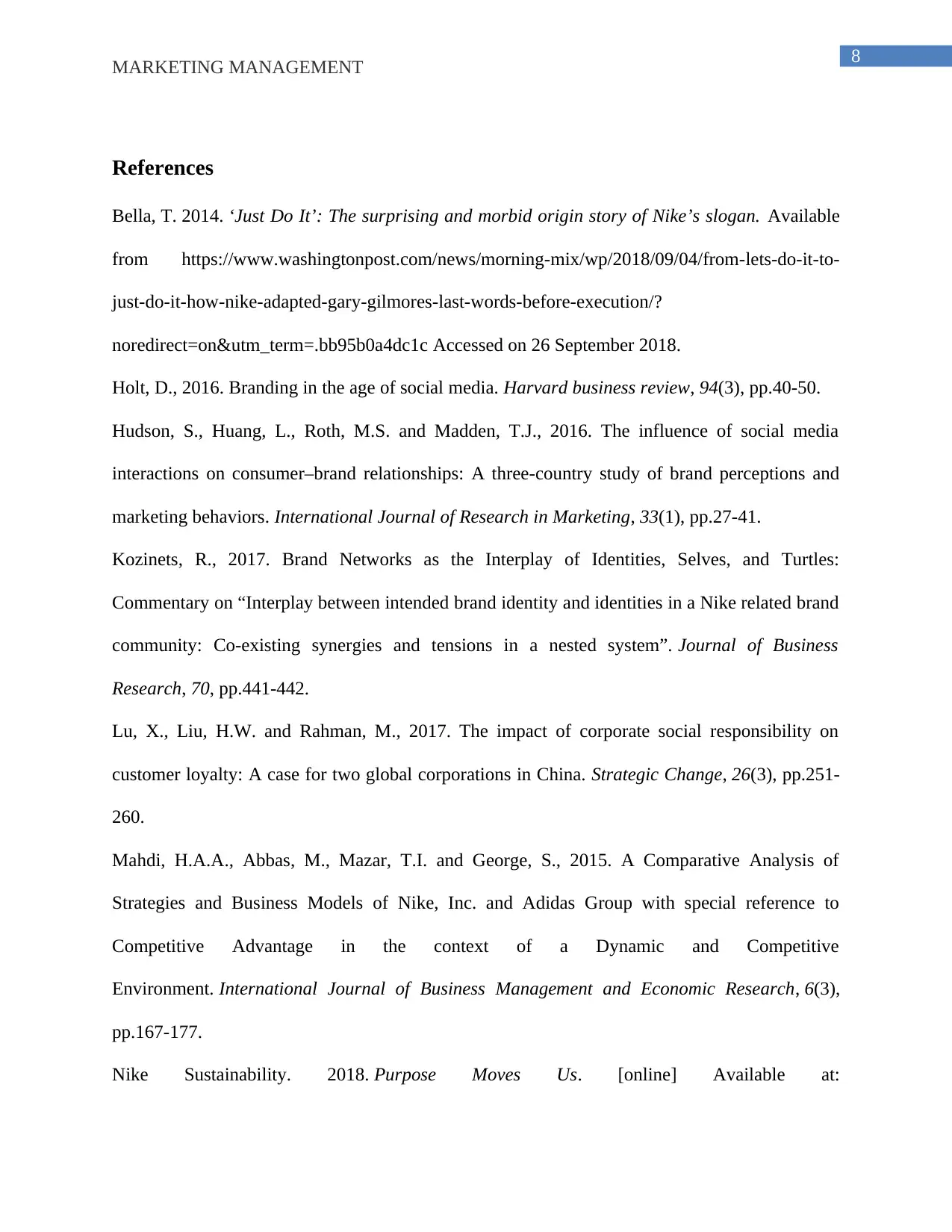
8
MARKETING MANAGEMENT
References
Bella, T. 2014. ‘Just Do It’: The surprising and morbid origin story of Nike’s slogan. Available
from https://www.washingtonpost.com/news/morning-mix/wp/2018/09/04/from-lets-do-it-to-
just-do-it-how-nike-adapted-gary-gilmores-last-words-before-execution/?
noredirect=on&utm_term=.bb95b0a4dc1c Accessed on 26 September 2018.
Holt, D., 2016. Branding in the age of social media. Harvard business review, 94(3), pp.40-50.
Hudson, S., Huang, L., Roth, M.S. and Madden, T.J., 2016. The influence of social media
interactions on consumer–brand relationships: A three-country study of brand perceptions and
marketing behaviors. International Journal of Research in Marketing, 33(1), pp.27-41.
Kozinets, R., 2017. Brand Networks as the Interplay of Identities, Selves, and Turtles:
Commentary on “Interplay between intended brand identity and identities in a Nike related brand
community: Co-existing synergies and tensions in a nested system”. Journal of Business
Research, 70, pp.441-442.
Lu, X., Liu, H.W. and Rahman, M., 2017. The impact of corporate social responsibility on
customer loyalty: A case for two global corporations in China. Strategic Change, 26(3), pp.251-
260.
Mahdi, H.A.A., Abbas, M., Mazar, T.I. and George, S., 2015. A Comparative Analysis of
Strategies and Business Models of Nike, Inc. and Adidas Group with special reference to
Competitive Advantage in the context of a Dynamic and Competitive
Environment. International Journal of Business Management and Economic Research, 6(3),
pp.167-177.
Nike Sustainability. 2018. Purpose Moves Us. [online] Available at:
MARKETING MANAGEMENT
References
Bella, T. 2014. ‘Just Do It’: The surprising and morbid origin story of Nike’s slogan. Available
from https://www.washingtonpost.com/news/morning-mix/wp/2018/09/04/from-lets-do-it-to-
just-do-it-how-nike-adapted-gary-gilmores-last-words-before-execution/?
noredirect=on&utm_term=.bb95b0a4dc1c Accessed on 26 September 2018.
Holt, D., 2016. Branding in the age of social media. Harvard business review, 94(3), pp.40-50.
Hudson, S., Huang, L., Roth, M.S. and Madden, T.J., 2016. The influence of social media
interactions on consumer–brand relationships: A three-country study of brand perceptions and
marketing behaviors. International Journal of Research in Marketing, 33(1), pp.27-41.
Kozinets, R., 2017. Brand Networks as the Interplay of Identities, Selves, and Turtles:
Commentary on “Interplay between intended brand identity and identities in a Nike related brand
community: Co-existing synergies and tensions in a nested system”. Journal of Business
Research, 70, pp.441-442.
Lu, X., Liu, H.W. and Rahman, M., 2017. The impact of corporate social responsibility on
customer loyalty: A case for two global corporations in China. Strategic Change, 26(3), pp.251-
260.
Mahdi, H.A.A., Abbas, M., Mazar, T.I. and George, S., 2015. A Comparative Analysis of
Strategies and Business Models of Nike, Inc. and Adidas Group with special reference to
Competitive Advantage in the context of a Dynamic and Competitive
Environment. International Journal of Business Management and Economic Research, 6(3),
pp.167-177.
Nike Sustainability. 2018. Purpose Moves Us. [online] Available at:
⊘ This is a preview!⊘
Do you want full access?
Subscribe today to unlock all pages.

Trusted by 1+ million students worldwide
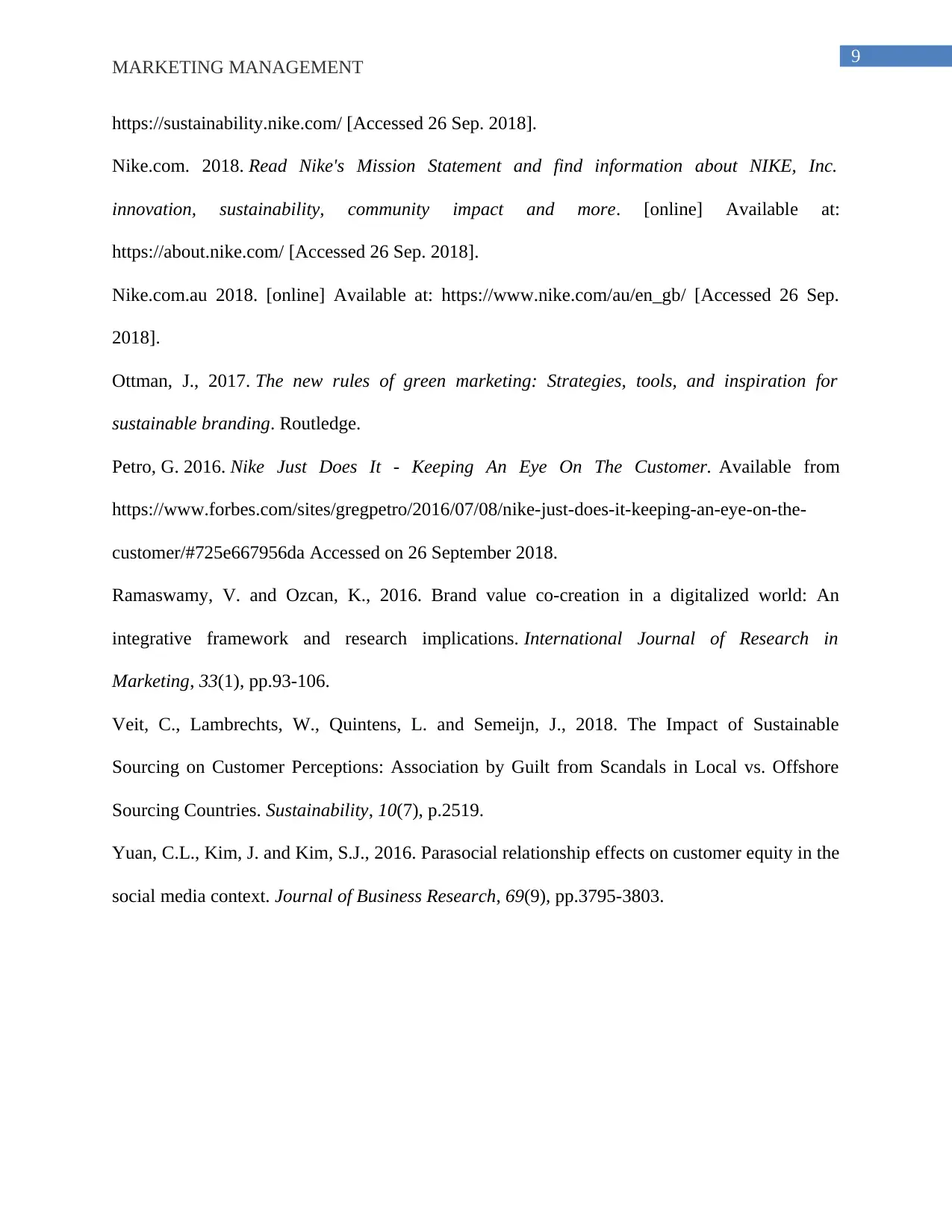
9
MARKETING MANAGEMENT
https://sustainability.nike.com/ [Accessed 26 Sep. 2018].
Nike.com. 2018. Read Nike's Mission Statement and find information about NIKE, Inc.
innovation, sustainability, community impact and more. [online] Available at:
https://about.nike.com/ [Accessed 26 Sep. 2018].
Nike.com.au 2018. [online] Available at: https://www.nike.com/au/en_gb/ [Accessed 26 Sep.
2018].
Ottman, J., 2017. The new rules of green marketing: Strategies, tools, and inspiration for
sustainable branding. Routledge.
Petro, G. 2016. Nike Just Does It - Keeping An Eye On The Customer. Available from
https://www.forbes.com/sites/gregpetro/2016/07/08/nike-just-does-it-keeping-an-eye-on-the-
customer/#725e667956da Accessed on 26 September 2018.
Ramaswamy, V. and Ozcan, K., 2016. Brand value co-creation in a digitalized world: An
integrative framework and research implications. International Journal of Research in
Marketing, 33(1), pp.93-106.
Veit, C., Lambrechts, W., Quintens, L. and Semeijn, J., 2018. The Impact of Sustainable
Sourcing on Customer Perceptions: Association by Guilt from Scandals in Local vs. Offshore
Sourcing Countries. Sustainability, 10(7), p.2519.
Yuan, C.L., Kim, J. and Kim, S.J., 2016. Parasocial relationship effects on customer equity in the
social media context. Journal of Business Research, 69(9), pp.3795-3803.
MARKETING MANAGEMENT
https://sustainability.nike.com/ [Accessed 26 Sep. 2018].
Nike.com. 2018. Read Nike's Mission Statement and find information about NIKE, Inc.
innovation, sustainability, community impact and more. [online] Available at:
https://about.nike.com/ [Accessed 26 Sep. 2018].
Nike.com.au 2018. [online] Available at: https://www.nike.com/au/en_gb/ [Accessed 26 Sep.
2018].
Ottman, J., 2017. The new rules of green marketing: Strategies, tools, and inspiration for
sustainable branding. Routledge.
Petro, G. 2016. Nike Just Does It - Keeping An Eye On The Customer. Available from
https://www.forbes.com/sites/gregpetro/2016/07/08/nike-just-does-it-keeping-an-eye-on-the-
customer/#725e667956da Accessed on 26 September 2018.
Ramaswamy, V. and Ozcan, K., 2016. Brand value co-creation in a digitalized world: An
integrative framework and research implications. International Journal of Research in
Marketing, 33(1), pp.93-106.
Veit, C., Lambrechts, W., Quintens, L. and Semeijn, J., 2018. The Impact of Sustainable
Sourcing on Customer Perceptions: Association by Guilt from Scandals in Local vs. Offshore
Sourcing Countries. Sustainability, 10(7), p.2519.
Yuan, C.L., Kim, J. and Kim, S.J., 2016. Parasocial relationship effects on customer equity in the
social media context. Journal of Business Research, 69(9), pp.3795-3803.
1 out of 10
Related Documents
Your All-in-One AI-Powered Toolkit for Academic Success.
+13062052269
info@desklib.com
Available 24*7 on WhatsApp / Email
![[object Object]](/_next/static/media/star-bottom.7253800d.svg)
Unlock your academic potential
Copyright © 2020–2025 A2Z Services. All Rights Reserved. Developed and managed by ZUCOL.





